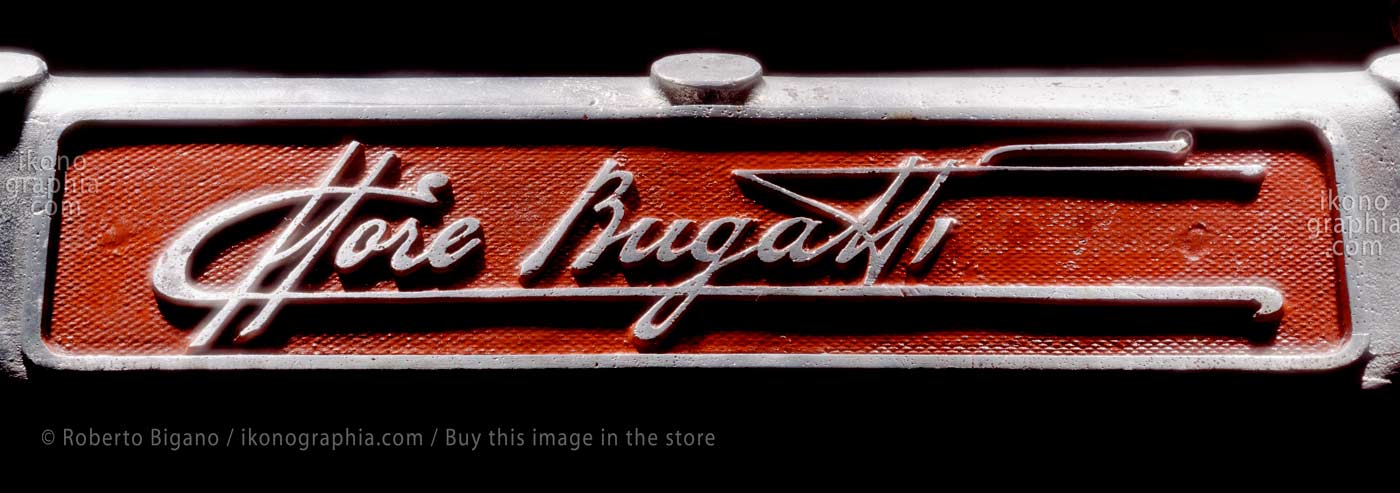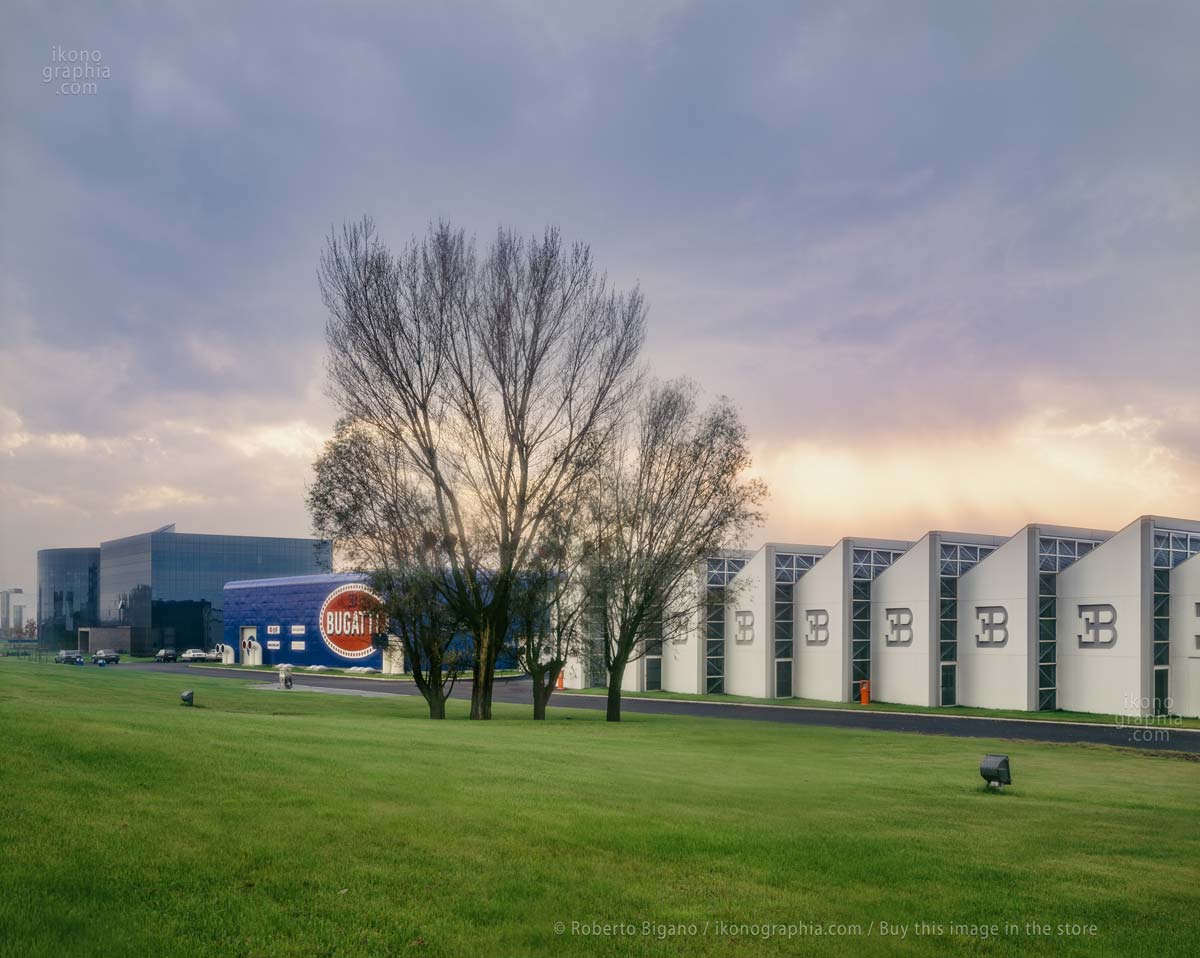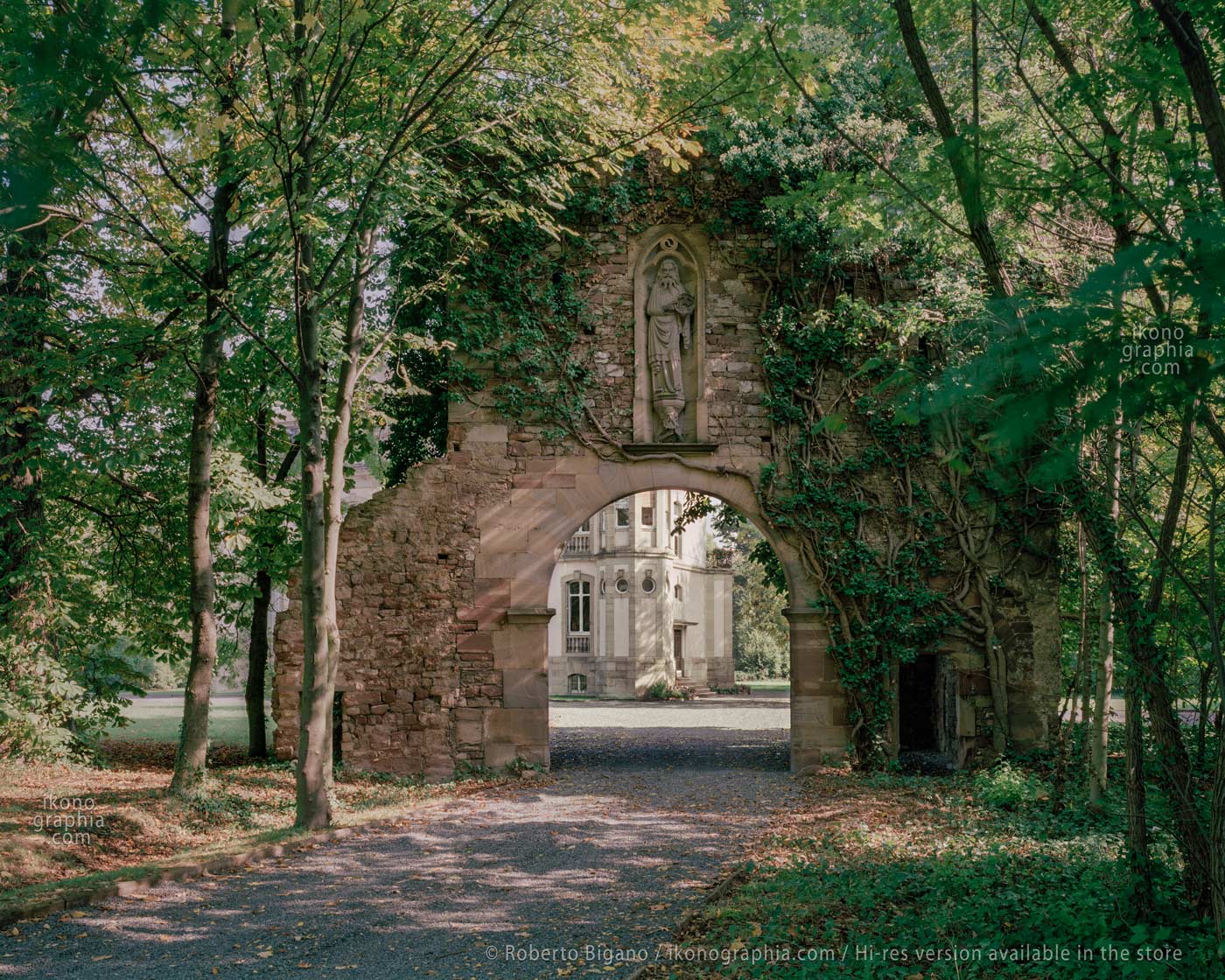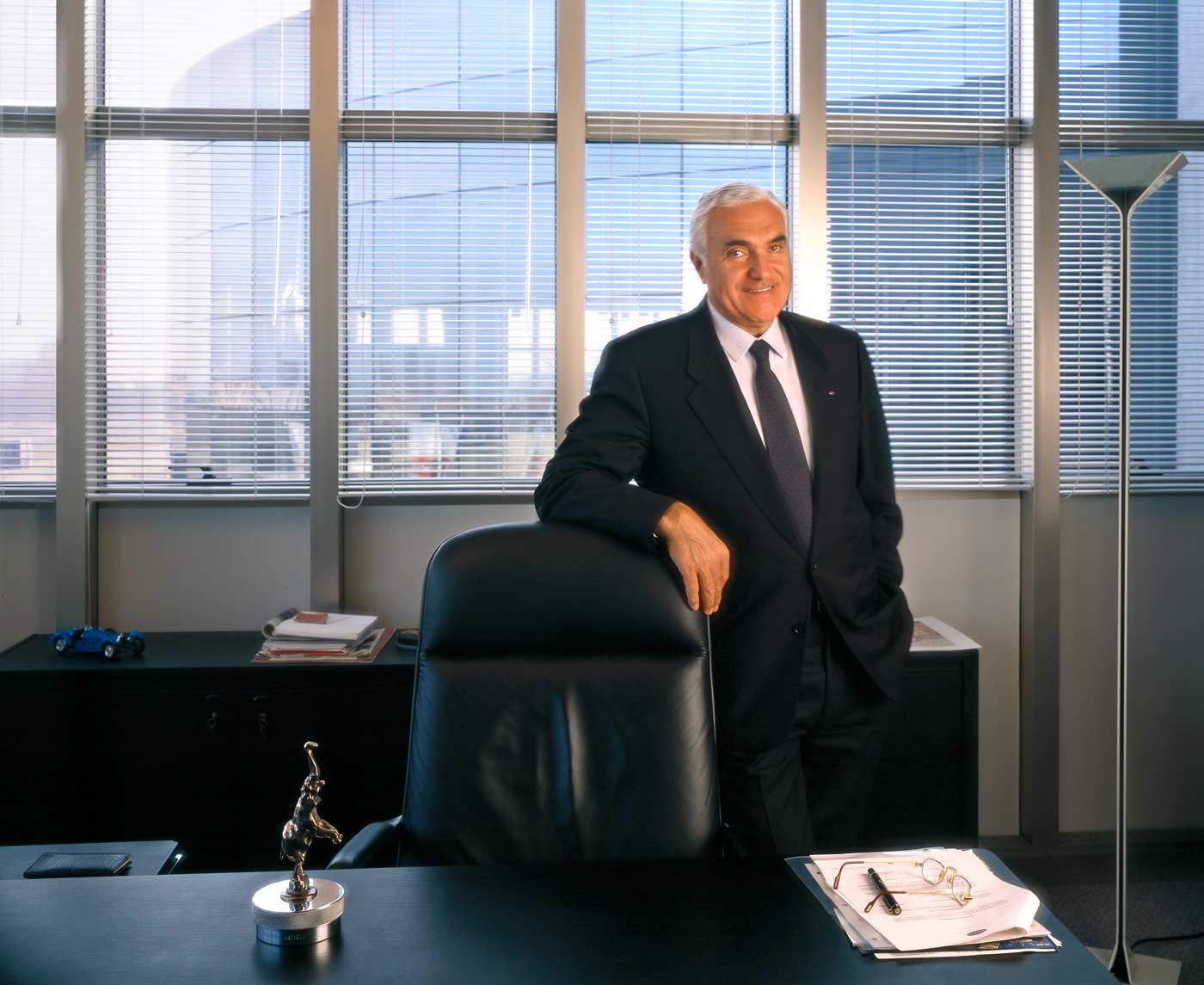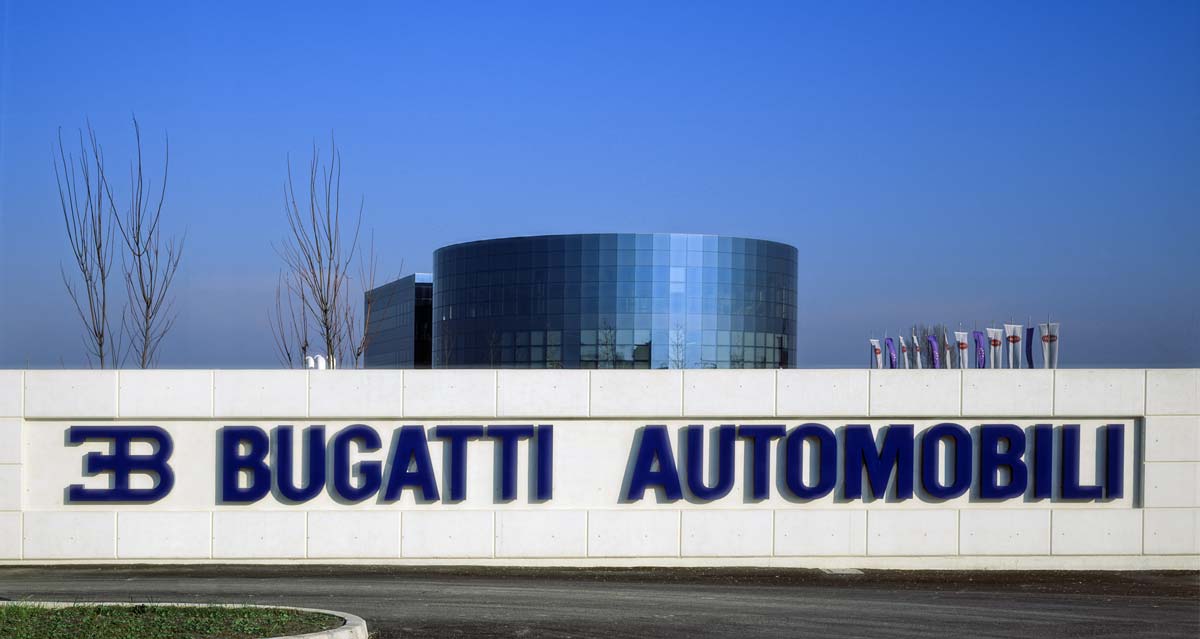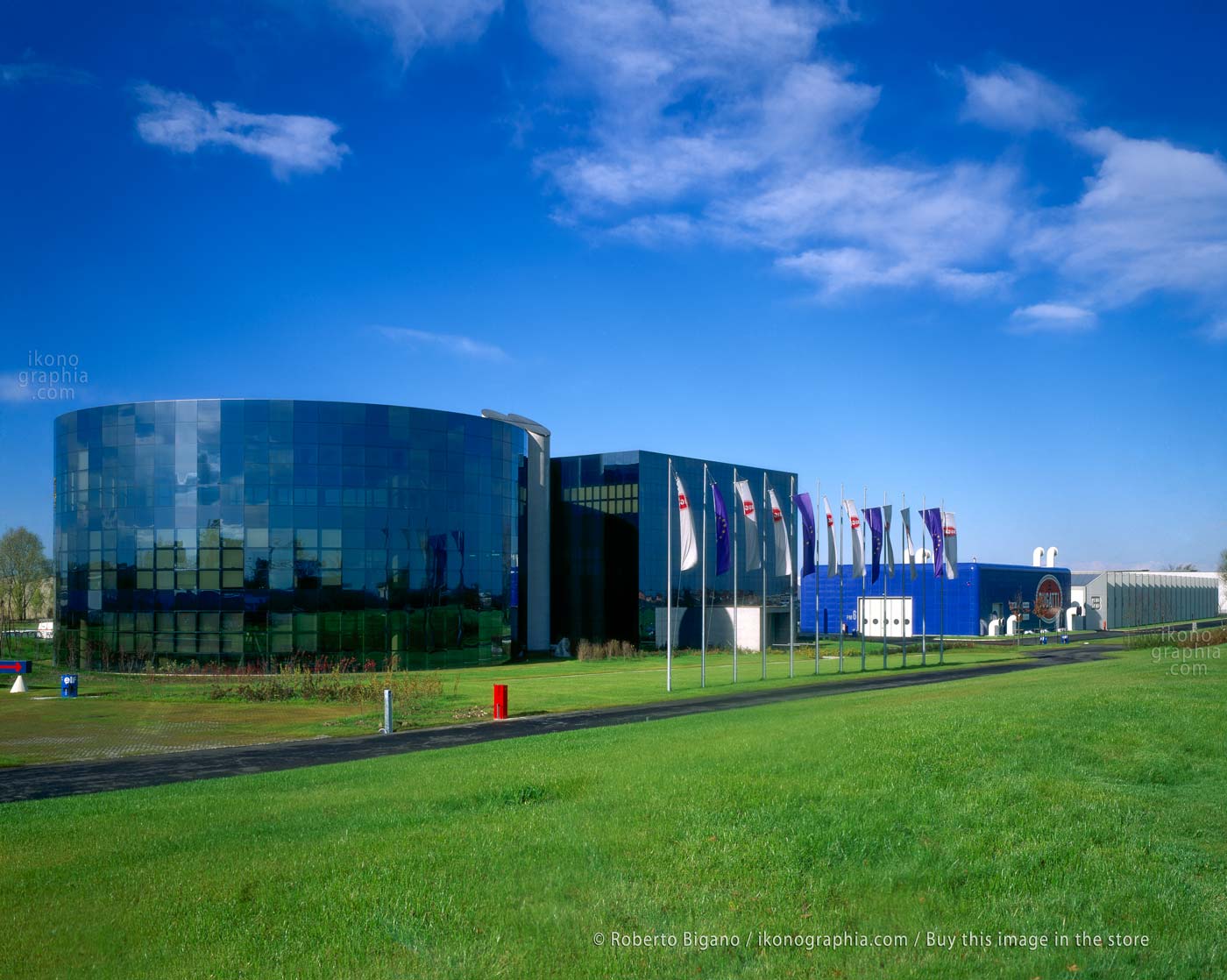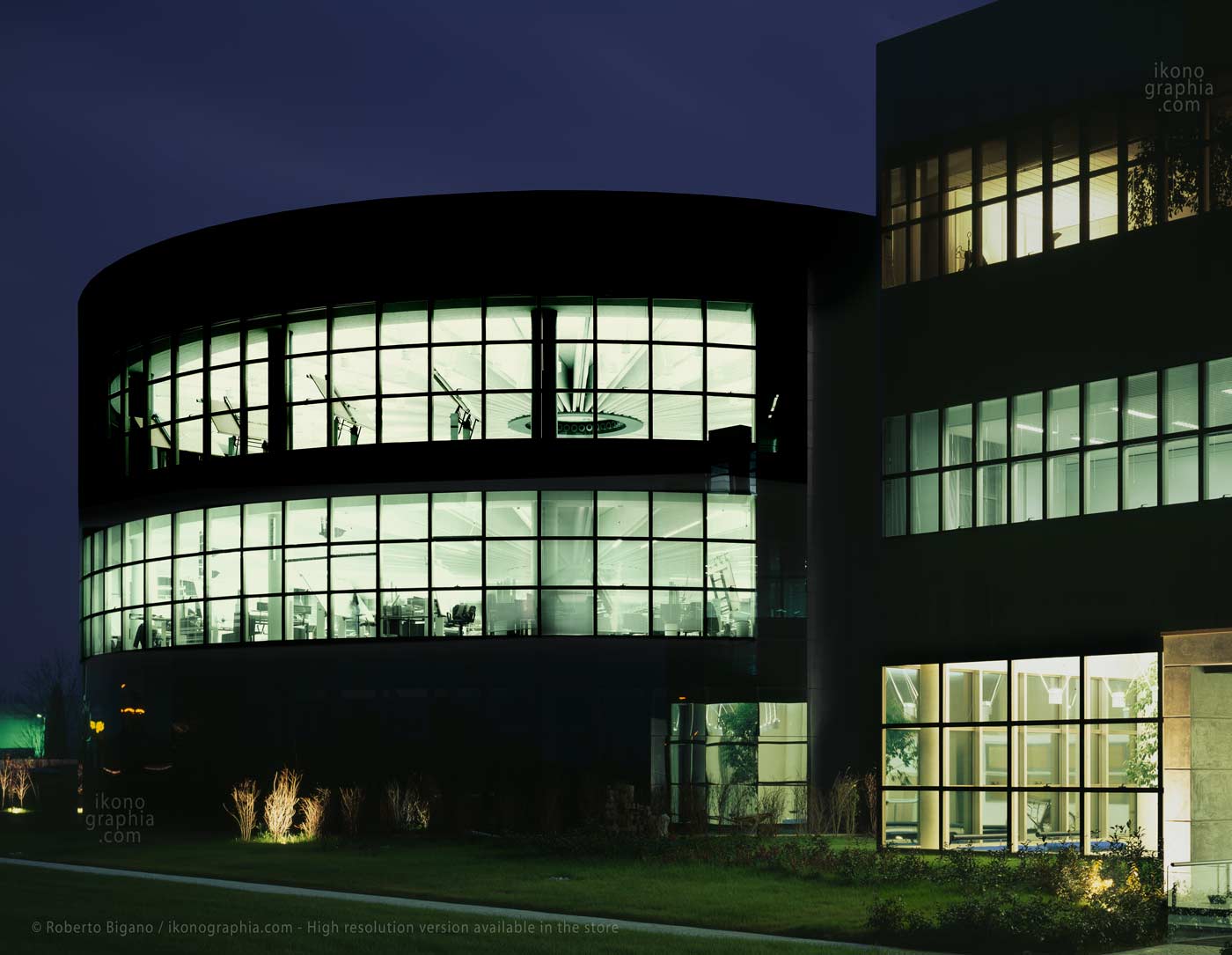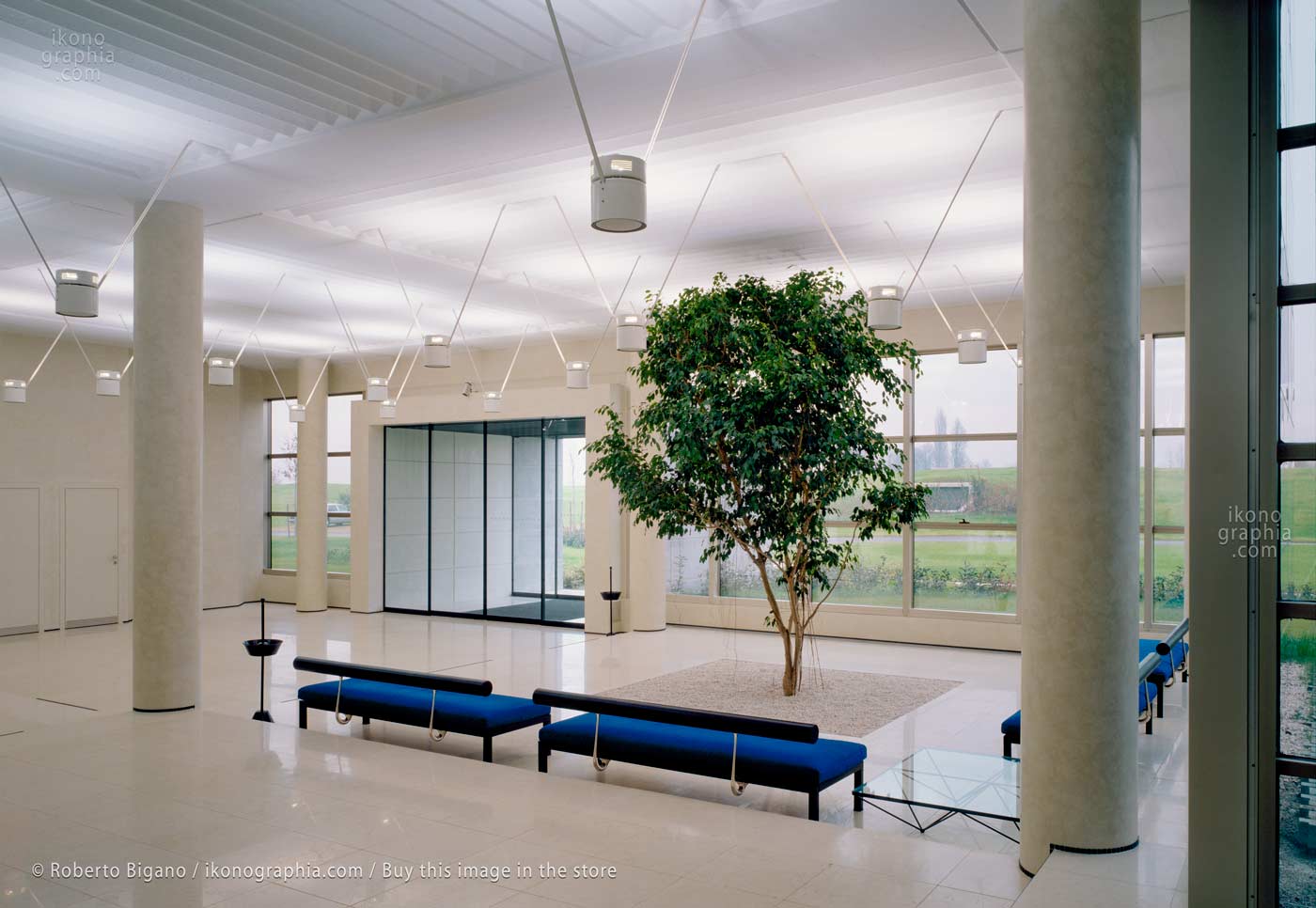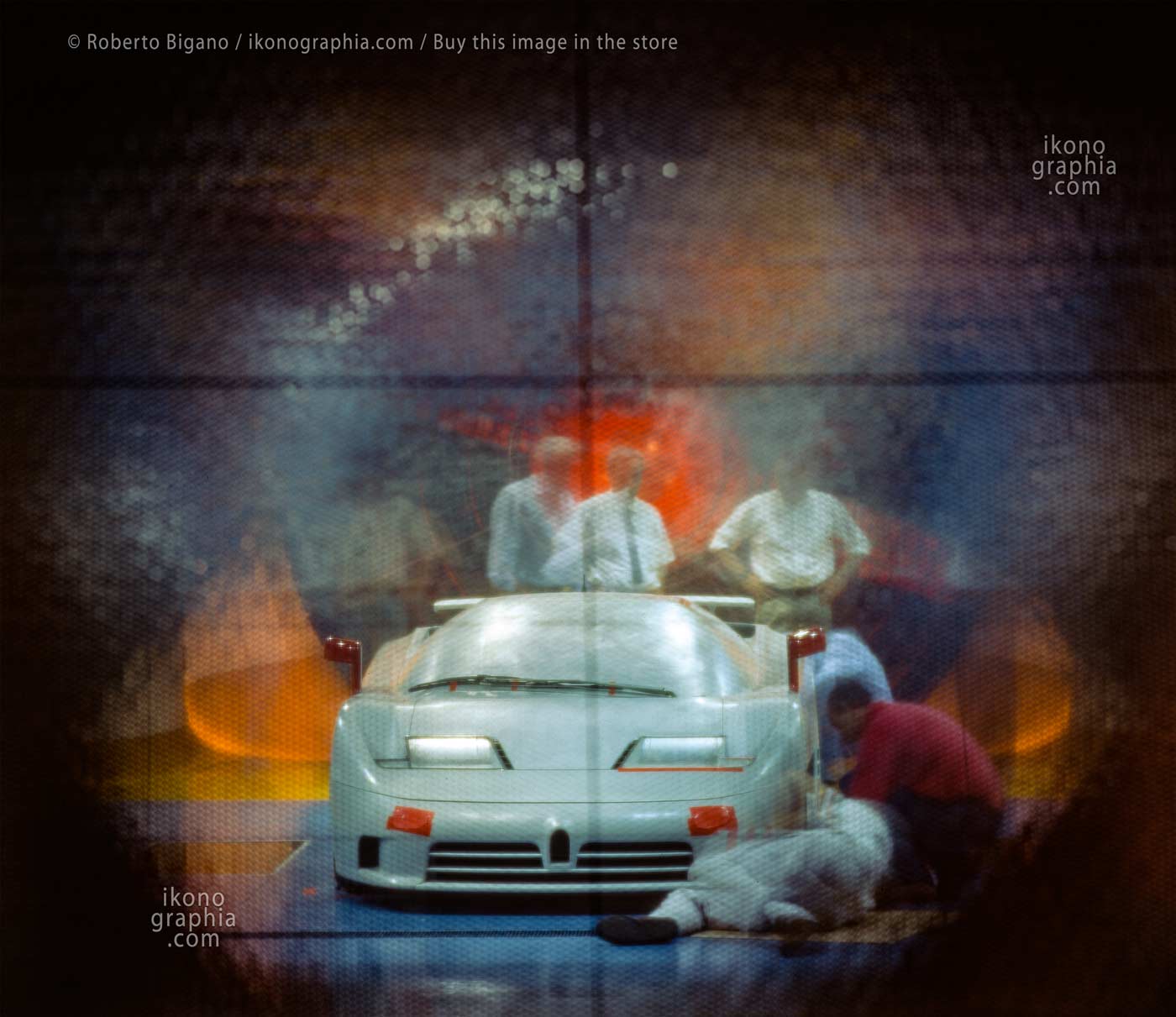The Great Adventure of Bugatti Automobili 1990s
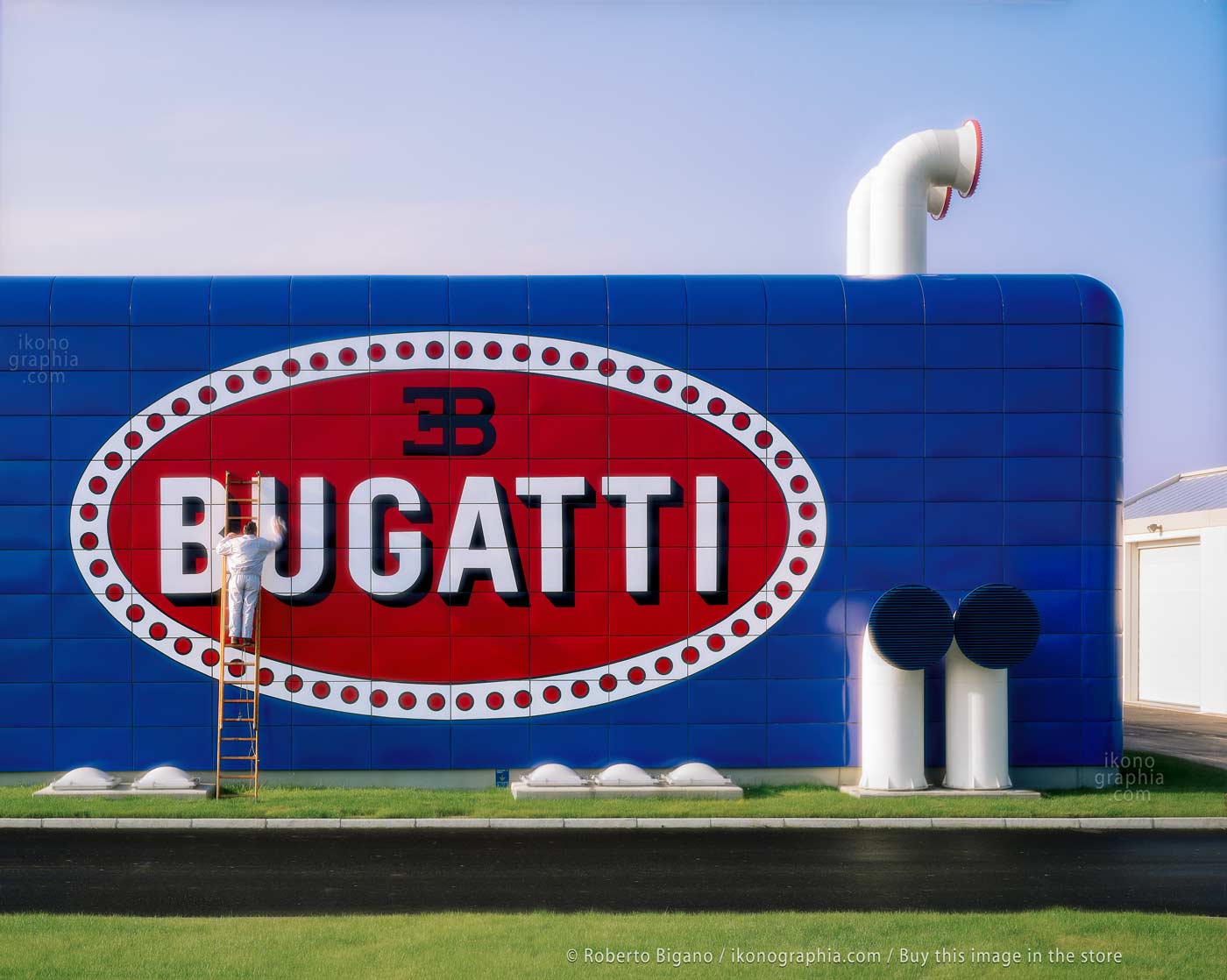
Cleaning the “Prove Motori” Building at Campogalliano. BUY
About Bugatti
Automobiles Ettore Bugatti was a French car manufacturer of high-performance automobiles, founded in 1909 in Molsheim, Alsace, France, by the Italian-born industrial designer Ettore Bugatti. The firm produced about 8,000 cars, known for their design beauty and their many race victories. The company struggled financially and released one last model in the 1950s.
In 1987, Romano Artioli, an Italian visionary entrepreneur, bought the brand and revived it in Campogalliano, Modena, as a builder of its time’s fastest series-production car. Bugatti Automobili produced a total of 128 cars. However, in 1995 the brand’s renaissance came to an abrupt end: the market for super sports cars collapsed, and demand fell dramatically. The factory was forced to close.
Volkswagen purchased the Bugatti trademark in June 1998. Bugatti Automobiles is now a subsidiary of Volkswagen AG, with its head office and assembly plant in Molsheim.
Leggi in italiano
Breve storia della Bugatti.
Automobiles Ettore Bugatti, a Molsheim, Alsazia, era un produttore francese di automobili da competizione e berline di lusso. Nelle corse vinse tutto ciò che si poteva vincere e nelle berline produsse modelli leggendari tra cui la Royale, l’Atalante e l’Atlantic. In totale dal 1909 al 1950 quando chiuse l’attività, produsse circa ottomila esemplari.
Nel 1987, Romano Artioli, un visionario imprenditore italiano, acquistò il marchio, dandogli nuovo lustro e producendo le più veloci, avanzate, ed esclusive vetture dell’epoca. Purtroppo nel 1995 la grande avventura di Bugatti Automobili ebbe fine: il mercato delle super sport era collassato e la fabbrica dovette chiudere. In totale furono prodotti 128 esemplari,
The legendary Ettore Bugatti signature on the engine head of a Bugatti Type13 Brescia.
La leggendaria firma di Ettore Bugatti sulla testa motore di una Tipo 13 Brescia.
The Dream Factory. La Fabbrica Blu.
The Bugatti factory of Campogalliano was one of the most advanced of the time.
Romano Artioli himself explains why.
“To make innovative cars, I thought it was essential to motivate workers. I always had in mind the factories I visited during my life: places of alienation and suffering. What we needed instead was an environment immersed in nature, which stimulates creativity. Therefore, the plant was designed to give technicians maximum comfort and the freedom to express their talent in the best possible way.
All the buildings had natural lighting. The measurement equipment was the most advanced. The air in the rooms was pollutants-free. The circular building where the designers worked on the upper floor was a jewel of avant-garde architecture, all in glass. The acoustic was also ideal for allowing designers to work without disturbance. There was a circular hall with a rotating platform on which cars were displayed on the ground floor. Last but not least, the plant was properly air-conditioned as the Modena climate varies from hot, humid summers to intense winter cold”.
From Romano Artioli’s book “Bugatti & Lotus Thriller.”
Leggi in italiano
La Fabbrica Blu.
La fabbrica Bugatti di Campogalliano era tra le più avanzate dell’epoca.
Romano Artioli in persona ci spiega il perché.
Per realizzare auto innovative, ritenevo indispensabile motivare coloro che ci avrebbero lavorato. Avevo sempre presente gli stabilimenti visitati nel corso della mia vita: luoghi di alienazione e sofferenza. Quello che serviva invece era un ambiente immerso nella natura, che stimolasse la creatività. Tutto lo stabilimento fu quindi progettato innanzitutto per dare ai tecnici il massimo comfort e la possibilità di esprimere al meglio il loro talento.
Tutti gli edifici godevano di illuminazione naturale. Le apparecchiature di misura erano le più avanzate tecnicamente, costruite espressamente per noi dagli specialisti delle attrezzature per prestazioni estreme Schenk. L’aria delle sale prova era totalmente priva d’inquinanti, pura come quella delle Dolomiti, per effettuare le analisi delle emissioni per le omologazioni.
La palazzina circolare, ai cui piani superiori lavoravano i progettisti, era un gioiello di architettura d’avanguardia, tutta in vetro. Le sue colonne portanti fungevano anche da canali per la circolazione dell’aria condizionata. Era dotata di pavimenti galleggianti per collegare in ogni punto i computer e le attrezzature speciali.
Anche l’acustica risultò ideale per permettere ai progettisti di lavorare senza disturbi di sorta. Al piano terra, leggermente interrato, era presente un salone circolare con al centro una pedana rotante a filo pavimento per esporre le auto. Indispensabile era che gli ambienti fossero ben condizionati, perché il clima modenese varia dal caldo soffocante dell’estate al freddo intenso dell’inverno, con un’umidità costante.
Dal libro di Romano Artioli: “Bugatti & Lotus Thriller.”
Winter view of the Bugatti Head-Quarter and Factory at Campogalliano / Veduta invernale dello stabilimento Bugatti a Campogalliano. BUY
Ikonographia celebrates Bugatti Automobili’s myth with three posts using the splendid images of Roberto Bigano, Bugatti’s photographer at the beginning of the 1990s. Through the story of his relationship with the Company, you can dive into the incredible mood created in those years.
Roberto Bigano, Bugatti’s photographer, tells all the story.
Everything started with a phone call from a copywriter friend, Beppe Maghenzani. Beppe was part of an overly ambitious project: to revitalize the Bugatti brand. Part of the project comprehended, creating a book that would illustrate the story of the Bugatti legend.
The initial thought was to have a photoshoot-themed “The Bugatti spirit today in Alsace,” a study of the legend’s birthplace. It is supposed to be a historical commemoration and, as the title said, but a spiritual evocation. For this intricate work, halfway between the archeological excavation and the mediumistic session, my friend Beppe thought of me as the best person for the job.
Leggi in italiano
Ikonographia celebra il mito di Bugatti Automobili con una serie di post, usando le splendide immagini di Roberto Bigano, fotografo di Bugatti nei primi anni novanta. Attraverso il racconto del suo rapporto con l’azienda, sarete in grado di immergervi completamente nell’atmosfera assolutamente unica che si era creata in quegli anni.
Roberto Bigano, fotografo di Bugatti Automobili vi racconta tutta la storia.
Tutto cominciò con una telefonata di un amico copywriter che avevo conosciuto sotto naja: Beppe Maghenzani. Beppe era stato coinvolto in un progetto estremamente ambizioso: rilanciare il marchio Bugatti. Il lavoro prevedeva una serie di iniziative tra le quali la realizzazione di volumi che degnamente illustrassero la storia del mito Bugatti.
Si pensò prima di tutto ad un servizio fotografico dal tema “Lo spirito Bugatti oggi in Alsazia”, un’indagine nei luoghi natali del mito, insomma, che ne fosse non solo storica rievocazione ma anche, come diceva il titolo, evocazione “spirituale”. Per questo complesso lavoro, a mezza via tra lo scavo archeologico e la seduta medianica, l’amico Beppe pensò a me come alla persona più adatta.
Molsheim, Alsace, France. Chateau St. Jean, the former Headquarter of Bugatti, at the time in ruin, but still fascinating.
Chateau St. Jean a Molsheim in Alsazia, sede della Bugatti, a quel tempo in rovina, ma comunque affascinante.
Romano Artioli, founder of Bugatti Automobili in his office at Campogalliano / Romano Artioli nel suo ufficio a Campogalliano. BUY
How I met Romano Artioli.
I returned home with the fruits of my mission in Alsace. The appointment with the client was in Ora, near Bolzano. I was met by Romano Artioli’s wife, Renata Kettmeir. “Nice work,” she commented after the first few images. “And since you’re doing such a good job, please feel free to go to Campogalliano to finish it.”
At the new Bugatti premises, I was immediately received by Romano Artioli. I was literally speechless when Mr. Artioli began discussing work. “Fine, Mr. Bigano, you are to document the history of new Bugatti, its cars, and the company. You are to illustrate the birth of the legend through every stage in the journey.
I want it all: successes and failures, moments of euphoria and suffering, designing, mechanics’ sweat, the wind gallery – in short, everything right up to the presentation of the new EB110 to be released next year in Paris, and the following Gran Gala evening at Versailles.”
“But Mr. Artioli,” I replied, embarrassed and shocked. How can you be sure I’m capable of coping with it if you don’t know me and you’ve never seen a photo of mine?” “Listen,” he answered. “I’ve never yet found a photographer to please my wife. If you’ve made a good impression on her, then you must be excellent.”
Leggi in italiano
Il mio incontro con Romano Artioli.
Tornai quindi alla base con il risultato della mia missione in Alsazia. L’appuntamento con il cliente era ad Ora in provincia di Bolzano. Fui ricevuto dalla moglie di Romano Artioli, Renata Kettmeir, cui piacque il lavoro. “Visto che lavora così bene vada pure a Campogalliano, così potrà completare il servizio”.
Alla sede della nuova Bugatti fui ricevuto subito da Romano Artioli. Rimasi letteralmente senza fiato quando Artioli iniziò a parlarmi di lavoro senza chiedermi di vedere una sola foto. “Bene Signor Bigano,” furono le parole con le quali esordì “lei deve documentarmi la storia della Bugatti, delle automobili, dell’azienda, deve testimoniare la nascita del mito attraverso ogni sua tappa. Voglio tutto, i successi ma anche gli insuccessi, i momenti di euforia come i periodi di sofferenza, i trionfi alle gare come gli errori, la progettazione, il sudore dei meccanici, la galleria del vento, tutto insomma fino al giorno della presentazione della nuova EB110 che faremo l’anno prossimo a Parigi, oltre al Gran Galà nella reggia di Versailles”.
“Ma Signor Artioli” gli risposi imbarazzato ed esterrefatto “Come può essere sicuro che io sia in grado di portare a termine un lavoro così complesso se non mi conosce nemmeno e non ha visto una sola mia fotografia?” “Guardi” mi rispose Romano Artioli. “Non ho mai trovato un fotografo che andasse bene a mia moglie. Se piace a lei, dev’essere bravissimo”. Ve lo giuro, mi disse proprio così.
The entrance of Bugatti Automobili at Campogalliano with the circular building / L’entrata principale della Bugatti Automobili. BUY
Working for “Bugatti Automobili.”
That’s what he said, and that’s how the great adventure started – and I worked for Bugatti almost full-time for a whole year. It was a thrilling experience, an incredible situation.
The company was a true gem, and I was treated like a prince; I felt like Benvenuto Cellini at the Medici court. Wherever I went and whatever I needed, I was supported in everything and for everything by a legion of assistants.
Mr. Artioli liked my work and introduced me to a thousand potential clients. “He is an artist, the best”; “his photos have a soul.” At the same time, he nicknamed me “Dolce Vita,” meaning I wasn’t working hard enough.
Working with Romano Artioli was stimulating because he was able to get the most out of me. Sometimes he even went so far as to give me suggestions. The post’s featured photo of the “cleaning works at Campogalliano” was his idea.
Leggi in italiano
Lavorare per Bugatti Automobili.
Iniziò così quella grande avventura. Per un intero anno avrei lavorato quasi full-time per la Bugatti. Fu un’esperienza esaltante, una situazione incredibile. L’Azienda era un gioiello e venivo trattato come un principe, mi sentivo come Benvenuto Cellini alla corte medicea. Ovunque andassi e qualunque cosa mi servisse ero assistito in tutto e per tutto da uno stuolo di assistenti di tutte le razze.
Dal canto suo Artioli magnificava le mie doti ad ogni visitatore dell’azienda (ed erano tutti personaggi di calibro): “Vi presento il miglior fotografo del mondo. E’ un artista”, “le sue foto hanno un’anima.” Allo stesso tempo mi aveva soprannominato “Dolce Vita”, perché a suo dire non lavoravo abbastanza!
Lavorare con Romano Artioli era stimolante; era in grado di tirare fuori il massimo da me. Alla volte addirittura mi dava delle dritte notevoli. Ad esempio la foto che apre il post “Cleaning Works at Reparto Motori” fu una sua idea.
General view of the “Blue Factory” / Veduta generale della “Fabbrica Blu”. BUY
Gianpaolo Benedini introduces the Bugatti Production Facility Complex
The industrial complex of Campogalliano was designed by the architect Gianpaolo Benedini with avant-garde criteria. It comprises three main modules, aesthetically different, creating a whole with an absolute functional and aesthetic value. Mr. Benedini himself tells us how he got there.
In the mid-spring of 1989, I got a call from Romano Artioli. He had bought a potato field in Campogalliano to build the Bugatti headquarters. I had earned his trust by converting a former factory into the Subaru Italia headquarters in record time.
Mr. Artioli put me in contact with the engineer Stanzani, the technical director, and Pedrazzi, Bevini, Benedetti, the specialized operators. Together we began to tackle the problems related to timing, different functions, and relative dimensions.
In those days, people were still designing on tracing paper with the drafting machine, and —believe me—, it was faster than today, and short times were foreseen.
Given the operational complexity, I decided to think with three different main functional typologies, the offices, the production, and the test rooms building. Once I prepared some sketches to identify each building’s positions considering any future developments, I began the executive design.
I decided to proceed in parallel with the different buildings, using prefabricated parts. In this way, times were reduced and optimized. So it happened that, while the foundations were being carried out on-site, the slabs and facades of the office building were created elsewhere, with an organized path that everyone respected.
Leggi in italiano
L’architetto Gianpaolo Benedini introduce il complesso industriale di Campogalliano.
Progettato con criteri di avanguardia, lo stabilimento è composto di tre moduli principali, diversi tra loro che creano un insieme dal valore funzionale ed estetico assoluto. Gianpaolo Benedini in persona ci racconta tutta la storia.
Nella primavera del 1989, Romano Artioli mi telefonò dicendomi che aveva comprato un campo di patate a Campogalliano per costruire la sede della Bugatti. Mi ero guadagnato la sua fiducia riconvertendo a tempi record una ex fabbrica, nella sede della Subaru Italia.
Mi raccontò quale era il suo obbiettivo e mi mise in contatto con l’ing. Stanzani che aveva in quel momento la direzione tecnica e con Pedrazzi, Bevini, Benedetti, gli operativi tecnici che avevano la responsabilità di mettere in pratica il sogno di Romano. Con loro cominciai ad affrontare i problemi legati alle tempistiche, alle diverse funzioni e relative dimensioni.
Il lavoro era estremamente complesso, ed i tempi ristretti. A quei tempi si progettava ancora su carta da lucido con il tecnigrafo e devo dire che fu un vantaggio perché era un modo di lavorare snello e veloce.
Vista la complessità operativa, decisi di ragionare su tre diverse principali tipologie funzionali, uffici, produzione ed il corpo destinato ad accogliere le sale prova. Predisposti alcuni schizzi per identificare le posizioni di ogni fabbricato, considerando eventuali futuri sviluppi, cominciai la progettazione esecutiva.
Considerando la necessità di completare lo stabilimento per fasi, ma in tempi brevissimi, decisi che era necessario procedere con la costruzione in cantiere e, parallelamente in stabilimenti vari, per le parti prefabbricate. In tal modo furono ridotti e ottimizzati i tempi. Mentre si eseguivano le fondazioni in opera, solai e facciate del fabbricato uffici venivano realizzati con un percorso organizzato che tutti rispettarono. Devo dire che tutte le imprese coinvolte di qualsiasi dimensione e posizione geografica furono contagiate dalla febbre Bugatti.
I progetti furono realizzati in sinergia con l’ing. Magistrelli (che ebbe la responsabilità delle strutture e degli impianti) ritrovato dopo alcuni anni di frequentazione comune al liceo. Tutta la parte edile fu realizzata dall’impresa mantovana Martinotti.
Architect Gianpaolo Benedini portrayed in the middle of the rotating platform, in the circular building’s basement floor. BUY
L’architetto Gianpaolo Benedini ritratto nel centro della piattaforma rotante nel salone circolare da lui progettato.
The Circular Building
The circular building, where the designers worked on the upper floors, was a jewel of avant-garde architecture, all in glass. Its supporting columns also served as funnels for the air conditioning circulation system. It was equipped with floating floors so that computers and special equipment could be connected at every point. The acoustics were also ideal for allowing designers to work without disturbance.
On the ground floor, which was slightly underground, there was a circular hall that had a rotating platform in the middle flush with the floor on which cars were displayed and which was also used for meetings and photography sessions. It was essential that the rooms be well air conditioned as the Modena climate varies from suffocating summer heat to intense winter cold, with constant humidity.
Leggi in italiano
L’edificio circolare.
La palazzina circolare, ai cui piani superiori lavoravano i progettisti, era un gioiello di architettura all’avanguardia, tutta in vetro. Le sue colonne portanti fungevano anche da canali per la circolazione dell’aria condizionata. Era dotata di pavimenti galleggianti per collegare in ogni punto i computer e le attrezzature speciali.
Anche l’acustica risultò ideale per permettere ai progettisti di lavorare senza disturbi di sorta.
Al piano terra, leggermente interrato, era presente un salone circolare che al centro aveva una pedana rotante a filo pavimento sulla quale venivano esposte le auto, utilizzato anche per le riunioni.
The bright, futuristic engineers’ hall, on the first floor of the building, designed with radii on the edges. BUY
L’avveniristico e luminoso salone circolare dei progettisti al primo piano dell’edificio.
The Main Building housing the hall and the offices.
This fully glazed cubic building houses the large luxury hall carpeted with Carrara marble and laid with mosaics and the offices. It is connected with the circular building equipped with floating floors to connect computers and special equipment at every point. Again Mr. Benedini tells.
On September 15, 1990, the facility was inaugurated with a ceremony that sealed the twinning with Molsheim. The amazement of the guests was not only for the beautiful girls who welcomed them at the reception but also for grasping a different way of considering the workplace and workers.
Visitors were also stunned by the luminosity and functionality of the buildings
Leggi in italiano
L’edificio principale per hall ed uffici.
Il luminoso edificio cubico ospitava l’ampia e lussuosa hall, con pavimenti in marmo di Carrara e decorazioni in mosaico. Era connesso con l’edificio circolare, ed i pavimenti galleggianti permettevano di connettere facilmente computer ed apparecchiature speciali. Ancora una testimonianza di Gianpaolo Benedini.
Quando il 15 settembre del 1990, lo stabilimento fu inaugurato con una cerimonia che sigillava il gemellaggio con Molsheim, lo stupore degli invitati non fu solo per le bellissime ragazze alla reception ma anche nel cogliere un modo diverso di considerare il posto di lavoro che vedeva al centro l’uomo, secondo la volontà di Romano Artioli; con grande soddisfazione di noi tecnici che eravamo riusciti a concretizzarla. La luce, la chiara corrispondenza tra l’architettura e la funzionalità di ogni diversa tipologia di quanto era stato costruito, erano riuscite a trasmettere i valori effettivi che avevamo come obiettivo.
Main building night view / Vista notturna dell’edificio principale. BUY
Ferida Fava and Karen Angus at the desk of the large and bright luxury reception, carpeted with Carrara marble and laid with mosaics. BUY
Ferida Fava e Karen Angus alla reception dell’ampia, luminosa e lussuosa hall, in marmo di Carrara ed inserti in mosaico.
The Bugatti main hall, in Carrara marble. On the bottom, an Ettore Bugatti bronze bust. BUY
La hall Bugatti, pavimentata in marmo di Carrara. Sullo sfondo il busto in bronzo di Ettore Bugatti.
Another view of the main hall / Un’altra vista della hall. BUY
Another gem of the architect Benedini: the entrance to the elevators. On the side, the bronze bust of Ettore Bugatti. BUY
Un’altra gemma dell’architetto Benedini: l’entrata agli ascensori. A lato il busto in bronzo di Ettore Bugatti.
Another exquisite detail. The doors of the offices on the ground floor. BUY
Ancora uno splendido particolare; le porte degli uffici al piano terra.
To follow the development of EB 110 (110 years since the birth of Ettore Bugatti), it was necessary to start with the building dedicated to development and tests on the engine.
Thus, it was the first building built with solid concrete with blue metallic skin like many racing Bugattis.
With the Bugatti emblem and the large white ventilation pipes, this impressive building symbolizes the factory’s heart and soul. The immense Bugatti logo, visible from miles away, was a symbol of belonging and pride.
Leggi in italiano
Il reparto “Prove Motori”.
Per procedere a pari passo con lo sviluppo dell’auto, che già si sapeva si sarebbe chiamata EB 110 (110 anni dalla nascita di Ettore Bugatti), si doveva cominciare dallo sviluppo e dai test sul motore. Per questa ragione il primo edificio da realizzare fu destinato ai banchi prova, un corpo di solido calcestruzzo con la pelle metallica blu, come molte Bugatti da competizione del passato.
Questo impressionante, originale edificio con l’emblema Bugatti e i grandi camini angolari, rappresentavano lo spirito e l’anima dell’azienda. L’immenso marchio, visibile a chilometri di distanza era un simbolo di orgoglio ed appartenenza.
Above and below two views of the “Prove Motori”, the Development building. The Bugatti emblem and the large white ventilation pipes symbolized the heart and soul of the factory.
Sopra e sotto due viste del reparto Prove Motori”. L’emblema Bugatti e i grandi camini angolari, simboleggiavano lo spirito e l’anima dell’azienda. BUY image above or BUY image below
The Production Building.
According to Mr. Artioli, to make innovative cars, it was essential to motivate the workers. “I always had in mind the factories I visited during my life: places of alienation and suffering“. So the architect started from this brief.
Instead of long, dark factory warehouses, Benedini designed halls flooded by light. There were two twin buildings, one dedicated to production lines, the other to services, as recreational spaces and canteen. More than a canteen, it was a quality restaurant, with no partition between workers, technicians, and managers, and even renowned guests, often including the Habsburg, expressly asked to eat there.
A clarification from Mr. Benedini.
All the projects were carried out in synergy with Engineer Magistrelli (responsible for the structures and systems), my former high school mate. The whole facility was built with the Mantuan company Martinotti.
Leggi in italiano
I reparti di Produzione.
Secondo Romano Artioli, per costruire macchine innovative era necessario motivare il personale. “Avevo sempre presente gli stabilimenti visitati nel corso della mia vita: luoghi di alienazione e sofferenza“. L’architetto seguì il suo brief alla lettera.
Invece di capannoni poco luminosi e funzionali, Benedini disegnò due edifici gemelli, spaziosi ed inondati dalla luce. Il primo era dedicato alle linee di produzione, il secondo ai servizi, tra cui spazi collettivi multifunzionali e mensa.
Più che mensa era un ristorante di qualità, senza divisione tra operai, tecnici e dirigenti, ed anche ospiti blasonati, tra cui spesso figuravano gli Asburgo, chiedevano espressamente di poter mangiare lì.
The iconic modular structure with Ettore Bugatti’s EB logo and the large windows guaranteed perfect natural lighting. BUY
L’iconica struttura modulare con il logo EB di Ettore Bugatti e le ampie vetrate che garantivano una perfetta illuminazione naturale.
One of the orderly and rational lines for processing powertrains by Mandelli Automatic Machines. Custom built for Bugatti Automobili to ensure the precision of one-thousandth of a millimeter.
Una delle ordinate e razionali linee per la lavorazione dei gruppi propulsori, effettuata dalle Macchine Automatiche Mandelli costruite appositamente per Bugatti Automobili, per garantire la precisione del millesimo di millimetro.
BUY the image above. BUY the image below.
Copyright and credits
Photographs by Roberto Bigano.
All the images in this post are copyrighted.
Tutte le immagini di questo post sono coperte da copyright.
About Roberto Bigano

Roberto's eye by Francesco Piras.
All the pictures on this page are by Roberto Bigano, an Italian photographer based in Verona, with branches in Naples and New York City. He developed special digital and high-resolution photography skills and taught photography at international workshops and conferences.
His books include Divina Bugatti and The Non-existing Knight, as well as countless art books, such as Berrocal for IVAM.
His work is a fascinating blend of high-profile projects, such as the high-resolution reproduction of Leonardo Da Vinci's works, and personal projects, starting from "Plastic Girls" and "Wonderful Mistakes," and most recently, a captivating exploration of New York City's Art Deco Architecture.
Read all Roberto's stories on this site.
About Roberto Bigano.
Browse or Buy his pictures as hi-res files in the Roberto Bigano Archive.
Browse or Buy his Fine-Art Prints
Dedicated pages on his works on Ikonographia: Bugatti Automobili, Bburago, "Plastic Girls" (Mannequins), Sardinia Artistic Bread.

